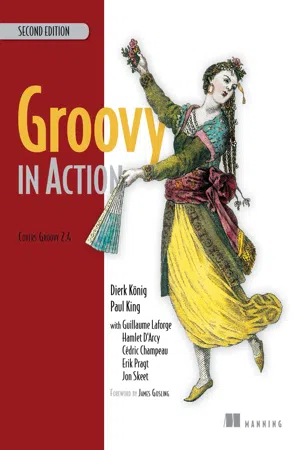
- 912 pages
- English
- ePUB (mobile friendly)
- Available on iOS & Android
Groovy in Action
About this book
Summary Groovy in Action, Second Edition is a thoroughly revised, comprehensive guide to Groovy programming. It introduces Java developers to the dynamic features that Groovy provides, and shows how to apply Groovy to a range of tasks including building new apps, integration with existing code, and DSL development. Covers Groovy 2.4.Purchase of the print book includes a free eBook in PDF, Kindle, and ePub formats from Manning Publications. About the Technology In the last ten years, Groovy has become an integral part of a Java developer's toolbox. Its comfortable, common-sense design, seamless integration with Java, and rich ecosystem that includes the Grails web framework, the Gradle build system, and Spock testing platform have created a large Groovy community About the Book Groovy in Action, Second Edition is the undisputed definitive reference on the Groovy language. Written by core members of the Groovy language team, this book presents Groovy like no other can—from the inside out. With relevant examples, careful explanations of Groovy's key concepts and features, and insightful coverage of how to use Groovy in-production tasks, including building new applications, integration with existing code, and DSL development, this is the only book you'll need. Updated for Groovy 2.4.Some experience with Java or another programming language is helpful. No Groovy experience is assumed. What's Inside
- Comprehensive coverage of Groovy 2.4 including language features, libraries, and AST transformations
- Dynamic, static, and extensible typing
- Concurrency: actors, data parallelism, and dataflow
- Applying Groovy: Java integration, XML, SQL, testing, and domain-specific language support
- Hundreds of reusable examples
About the Authors
Authors Dierk König, Paul King, Guillaume Laforge, Hamlet D'Arcy, Cédric Champeau, Erik Pragt, and Jon Skeet are intimately involved in the creation and ongoing development of the Groovy language and its ecosystem.
Table of Contents
PART 1 THE GROOVY LANGUAGE
- Your way to Groovy
- Overture: Groovy basics
- Simple Groovy datatypes
- Collective Groovy datatypes
- Working with closures
- Groovy control structures
- Object orientation, Groovy style
- Dynamic programming with Groovy
- Compile-time metaprogramming and AST transformations
- Groovy as a static language
- PART 2 AROUND THE GROOVY LIBRARY
- Working with builders
- Working with the GDK
- Database programming with Groovy
- Working with XML and JSON
- Interacting with Web Services
- Integrating Groovy
- PART 3 APPLIED GROOVY
- Unit testing with Groovy
- Concurrent Groovy with GPars
- Domain-specific languages
- The Groovy ecosystem
Frequently asked questions
- Essential is ideal for learners and professionals who enjoy exploring a wide range of subjects. Access the Essential Library with 800,000+ trusted titles and best-sellers across business, personal growth, and the humanities. Includes unlimited reading time and Standard Read Aloud voice.
- Complete: Perfect for advanced learners and researchers needing full, unrestricted access. Unlock 1.4M+ books across hundreds of subjects, including academic and specialized titles. The Complete Plan also includes advanced features like Premium Read Aloud and Research Assistant.
Please note we cannot support devices running on iOS 13 and Android 7 or earlier. Learn more about using the app.
Information
Part 1. The Groovy language
A good notation has subtlety and suggestiveness which at times makes it almost seem like a live teacher.Bertrand Russell The World of Mathematics (1956)
Chapter 1. Your way to Groovy
- What Groovy is all about
- How it makes your programming life easier
- How to start
It isn’t the mountains ahead to climb that wear you out; it’s the pebble in your shoe.Muhammad Ali
1 Thanks to Mac Liaw for this wording.
1.1. The Groovy story
Table of contents
- Copyright
- Brief Table of Contents
- Table of Contents
- Praise for the First Edition
- Foreword to the First Edition
- Preface
- Acknowledgments
- About this Book
- About the Authors
- Part 1. The Groovy language
- Part 2. Around the Groovy library
- Part 3. Applied Groovy
- Appendix A. Installation and documentation
- Appendix B. Groovy language information
- Appendix C. GDK API quick reference
- Appendix D. Cheat sheets
- Appendix E. Annotation parameters
- Appendix F. Compiler phases
- Appendix G. AST visitors
- Appendix H. Type checking extensions
- Appendix I. Android support
- Appendix.
- Index
- List of Figures
- List of Tables
- List of Listings